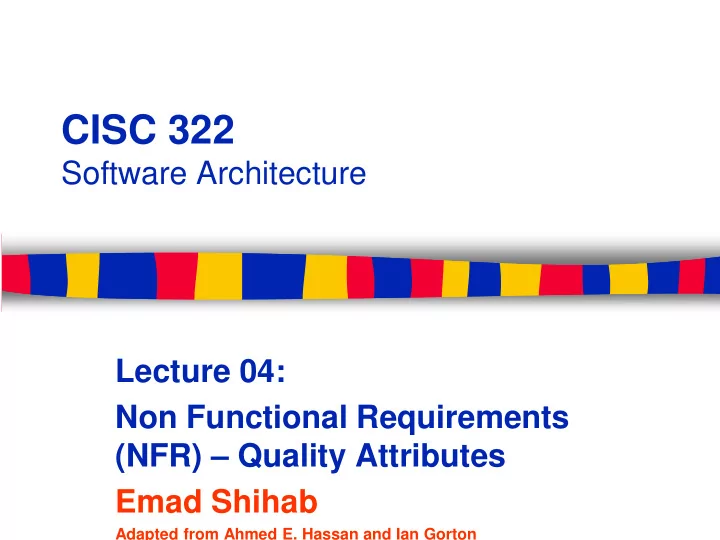

CISC 322 Software Architecture Lecture 04: Non Functional Requirements (NFR) – Quality Attributes Emad Shihab Adapted from Ahmed E. Hassan and Ian Gorton
Last Class - Recap ■ Lot of ambiguity within stakeholders ■ Focus on the needs, not wants ■ Specifications used to bridge gap between stakeholder demands and software system ■ Use system perspective diagram to isolate system from users and interfaces
What are Quality Attributes ■ Often know as –ilities – Reliability – Availability – Portability – Scalability – Performance
ICDE System ■ Information Capture and Dissemination Environment (ICDE) is a software system for providing intelligent assistance to – financial analysts – scientific researchers – intelligence analysts – analysts in other domains
ICDE ■ Automatically captures and stores data of actions performed by a user ■ Google search: – Record query – List of returned pages ■ Data can be later used by 3 rd parties to offer intelligent help
ICDE Schematic Local information repositories Internet ICDE Repository Analyst ICDE Recording Software 3 rd Party Tools
ICDE v2.0 Business Goals Business Goal Supporting Technical Objective Encourage third party tool Simple and reliable programmatic access to data Integration developers store for third party tools Heterogeneous (i.e. non-Windows) platform Portability support for running third party tools Allow third party tools to communicate with ICDE Reliability users from a remote machine Promote the ICDE concept to Scale the data collection and data store components Scalability users to support up to 150 users at a single site Low-cost deployment for each ICDE user Scalability workstation
Quality Attribute Specification ■ Architects are often told: – “My application must be fast/secure/scale” ■ Quality attributes must be precise/measurable for a given system design, e.g. – “It must be possible to scale the deployment from an initial 100 geographically dispersed user desktops to 10,000 without an increase in effort/cost for installation and configuration.”
Performance ■ Different ways to measure performance: – Throughput – Response Time – Deadlines
Performance - Throughput ■ Measure of the amount of work in unit time – Transactions per second – Messages per minute
Throughput Example CPU % MST (msp) 300 250 200 150 100 50 0 0 5 10 15 20 # of threads
Throughput Considerations ■ Is required throughput: – Average? (Video streaming) – Peak? (Bidding) ■ Many system have low average but high peak throughput requirements
Performance - Response Time ■ Latency or delay an application exhibits in processing a request – Often an important metric for users (Point-of- sales, stock trading)
Example Response Time ■ E.g. 95% of responses in sub-4 seconds, and all within 10 seconds
Response Time Considerations ■ Is required response time: – Guaranteed? (VOIP) – Average? (Search)
Performance - Deadlines ■ ‘something must be completed before some specified time’ – Payroll system must complete by 2am – Weekly accounting run must complete by 6am Monday
Something to watch for … ■ What is a – Transaction? – Message? – Request? ■ All are application specific measures. ■ System must achieve 100 mps throughput – BAD!! ■ System must achieve 100 mps peak throughput for PaymentReceived messages – GOOD!!!
ICDE Performance Issues ■ Response time: – Overheads of trapping user events must be negligible to users ■ Solution for ICDE client: – Decouple user event capture from storage using a queue 5. Write event to ICDE database queue 2. Write event 1. Trap user event to queue 4. Read event 3. Return to user thread from queue
Scalability ■ ‘How well a solution to some problem will work when the size of the problem increases ’ – Request Load – Connections – Data size – Deployment
Scalability – Request Load ■ How does an 100 TPS application behave when simultaneous request load grows? ■ Ideal solution: – as the load increases, throughput remains constant (i.e. 100 tps), and response time per request increases only linearly (i.e. 10 seconds).
Scalability – Add more hardware Application Scale-out: Application replicated on different machines Scale-up: Single application instance is executed Application on a multiprocessor machine CPU Application Application Application
Scalability - reality ■ Decrease in throughput and exponential increase in response time. – increased load causes increased contention for resources such as CPU, network and memory – each request consumes some additional resource (buffer space, locks, and so on) in the application, and eventually these are exhausted
Scalability - connections ■ What happens if number of simultaneous connections to an application increases – Each connection consumes a resource? – Exceed maximum number of connections?
Connections Example ■ ISP wants to scale to 100,000 users – Each user connection spawned a new process for targeted ads – Virtual memory on each server exceeded at 2000 users – Tech crash, ISP out of business
Scalability – Data Size ■ How does an application behave as the data it processes increases in size? – Chat application sees average message size double? – Database table size grows from 1 million to 20 million rows? – Image analysis algorithm processes images of 100MB instead of 1MB?
Scalability - Deployment ■ How does effort to install/deploy an application increase as installation base grows? – Install new users? ■ Solutions typically revolve around automatic download/installation – E.g. downloading applications from the Internet
Scalability thoughts ■ Scalability often overlooked – Major cause of application failure – Hard to predict – Hard to test/validate – Reliance on proven designs and technologies is essential
Scalability for ICDE ■ Should be capable of handling a peak load of 150 concurrent requests from ICDE clients. – Relatively easy to simulate user load to validate this
Next Class ■ Monday, Sep. 19 ■ Modifiability ■ Security ■ Availability ■ Integration
Recommend
More recommend